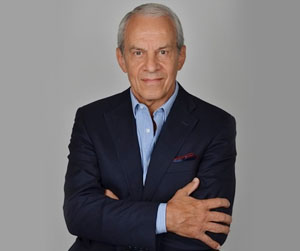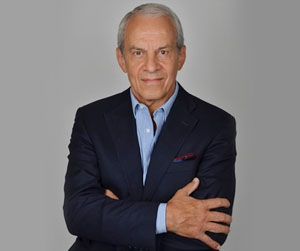Plastic surgery on the chin (profiloplasty)
Cosmetic chin surgery, called "genioplasty" or "mentoplasty", aims to correct the shape and size of the chin to balance the face. The shape of the chin gives strength and character to a face. The projection of the chin and cheekbones gives an impression of dynamism and these three points should ideally form an equilateral triangle.
This operation gives the face a harmonious appearance and therefore improves the aesthetics of the entire face.

Chin augmentation with prosthesis
Uses
One of the most frequent reasons for a consultation is that the chin is too small, which can give a suppressed look and sometimes a feeling of sagging around the neck, which lacks anterior support. The chin can then be augmented to give definition to the cervico-facial angle between the neck and chin.
Increasing the volume of the chin can be achieved either by using an implant for a significant augmentation or by non-surgical techniques such as hyaluronic acid injections or injecting your own body fat (lipofilling) for a moderate volume increase.
The implant can have different shapes that can extend more or less to the edge of the mandible or remain limited to the tip of the chin. The use of these different implant shapes will depend on your anatomy and the desired result.
Chin reduction is used for a prominent chin when the teeth are in a normal position. Indeed, in the event of prognathism, when the lower jaw protrudes more than the upper jaw, reducing the chin will need to take place through surgery for an overall reduction of all the lower jaw.
Each person arrives with a request to correct a particular defect that they find particularly troublesome. The objective of the operation will be to correct this defect as a priority by assessing whether it may be appropriate to correct other associated defects to have a well-balanced, natural result that meets your expectations.
At the same time as correcting the chin, it may be also useful to correct the nose to improve the harmonious look of the facial profile, which we call profiloplasty, or the cheekbones by hyaluronic acid injections or injecting your own body fat (lipofilling).
The operation can be performed when bones have stopped growing and the chin has stabilised in its final adult form, i.e. from about 16 years of age.
Consultation
During the first consultation, it is essential that you openly express what bothers you and what you would like to improve. Do not be afraid to ask any questions, including expressing your fears and expectations. Everyone has a different body shape, psychology and expectations. These are not the same and there is no standard to apply.
After you have explained your motivations, I will examine you to assess the aesthetic aspect and evaluate the projection of your chin and the functional aspect by assessing any respiratory or chewing problems and the position of your dental arches (an endo-oral examination).
I then offer one or more solutions, taking into account your expectations, your anatomy, preserving your identity and the naturalness of your appearance. Any change in the structure of the chin will take into account the shape of your face, your age and the thickness and condition of your skin.
So you can visualise the desired result, I will take photographs and accurately draw the changes we envisage on the photo. I will also show you pictures of surgical results of cases similar to yours so you can to understand the goals of the procedure.
It is essential that you and I have a good understanding when deciding to operate and to determine the technique to use among from those I can suggest.
I will then give you all the information on the techniques proposed along with the information sheets from the Société Française de Chirurgie Plastique Reconstructrice et Esthétique (French Society of Plastic, Reconstructive and Cosmetic Surgery) as well as a detailed estimate of the costs for the options chosen. You will then be able to progress your project and get ready for a second consultation when you will be able to ask any additional questions to help you make a decision and prepare for the operation.
Before the procedure
You must attend preoperative examinations:
-
A full or partial blood test depending on the type of anaesthetic (local or general).
-
A jaw X-ray.
In the event of a general anaesthetic, you will need a consultation with the anaesthetist in the weeks leading up to the operation and at least 48 hours before.
Recommendations:
No medications containing aspirin or anti-inflammatories can be taken within 10 days of the procedure.
If you are having a general anaesthetic, you must fast strictly for 6 hours before the operation (do not eat anything, chew gum, eat sweets or smoke). However, in case of local anaesthetic, you can to drink and eat lightly at normal mealtimes.
Tobacco consumption should be stopped or reduced as much as possible during the month before and month after the procedure. Tobacco can cause scarring problems.
The procedure
Hospitalisation and the duration of the procedure:
Your hospital stay is usually only half a day in a day clinic. Sometimes, you may need to stay in hospital the night after the operation.
The operation lasts for approximately 1 hour depending on the type of procedure and its complexity.
Type of anaesthetic:
Local, deep local (neuroleptanalgesia) or general according to your preferences. Most often, general anaesthetic is required.
Technique:
Before you go to the operating theatre, in your room, I will go over the precise goals with you as we agreed during the consultations. You can then always make recommendations and ask any questions. I then draw the lines and marks on your skin to guide the operation and the lines of the incisions.
Chin augmentation:
This is carried out by placing a silicone implant that fits over the projection of the chin bone.
The implant is inserted through the inside of the mouth (endo-oral route) from an incision made at the base of the gum.
Chin reduction:
To precisely control the reduction, it is not carried out all at once by removing a single section of the bone, but the chin is gradually reduced by filing it until the desired result is obtained.
The incision is hidden in the mouth, leaving no visible scar.
The stitches are very fine and absorbable and do not require removal.
The photographs are displayed in the operating room as a reference to guide the operation.
Thanks to its elasticity, the skin follows the bone structures once more and naturally finds its own position.
At the end of the operation, to stabilise the new shape, a flexible modelling dressing is applied to the chin to immobilise the new structure; this will be removed 5 to 8 days later, following the first post-operative consultation.
After the operation
Any pain is controlled by prescribing of analgesics.
There may also be bruising and swelling to the chin and neck, which can take up to 10 days to disappear almost completely. However, you can mask this with a cover cream the day after the operation.
You will need to take time out from work and social activities until the dressing is removed, i.e., about a week after your first post-operative consultation.
As the stitches are absorbable, these do not need to be removed.
Care:
You can clean your face with a mineral water spray.
You must rinse your mouth with an antiseptic mouth rinse after each meal and after brushing your teeth during the first week.
You should make a follow-up appointment 5-8 days after the procedure, then after 15 days, 1 month, 3 months, 6 months, and 1 year.
Recommendations:
-
Exposure to the sun: no direct exposure for 6 weeks, then exposure is allowed using sunscreen with a maximum protection factor.
-
Make-up: the bruises can be hidden by a cover cream the day after the operation; your usual make-up can be applied over the cover cream.
-
Sport: individual sports such as gymnastics or running can be resumed about fifteen days after the operation; team sports or sports involving a risk of trauma to the face (combat sport, ball, etc.) cannot be resumed for 3 months.
The result
An improvement can be seen straight away when the dressing is removed, despite any oedemas (swelling) and bruises that prevent a full assessment of the final result. After about ten days, progress will already allow us to see the result, even if stabilisation takes 1 to 6 months. The final result is really noticeable from 6 months after the operation.
In addition to a cosmetic improvement, this procedure has a beneficial impact on the personal well-being, behaviour and development of the patient who is relieved of their complex.
Risks and complications
Read the information from the French Society of Plastic, Reconstructive and Cosmetic Surgery (in French)
Price range
The cost of the operation will depend on the procedure to be carried out, the duration of the operation, the type of anaesthetic and any hospital charges.
If the reason for the operation is purely aesthetic, you cannot get reimbursement through a social security claim.
On the other hand, if it is for reconstructive purposes after an accident or an illness, you may be covered by social security and, where relevant, by your mutual insurance company.
A detailed estimate is given to you during the first consultation according to the options you have chosen. You then have a minimum legal period of 15 days to consider your options and take your project forwards.
The first consultation costs €50. The following consultations before and after the operation are free.
The photographs on this page are here to illustrate and complete the information given on the operations. They are merely for information purposes so you can see the goals, results and scars from the operation.
The likelihood of scarring and each patient’s individual anatomy are different. Therefore, for this reason, the photographs on this site do not commit Dr. Benelli to providing all patients with a similar result.
The information given on a site is not sufficient in itself and a medical consultation is essential to get the right information for each individual case. For this, you’ll need to consult a surgeon qualified in Plastic Reconstructive and Aesthetic Surgery.



